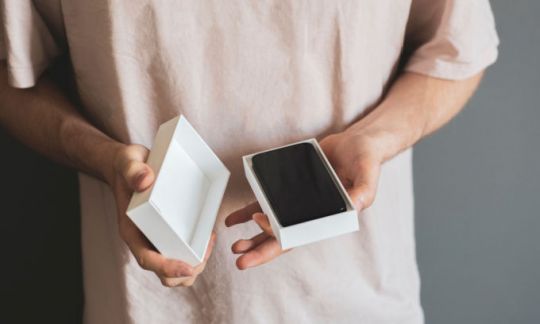Mobile Phone Insurance
A smartphone can be an expensive investment, and most of us rely on them in our everyday lives. So, what do you do if yours breaks? We look into the options when it comes to coverage for your phone.

A smartphone can be an expensive investment, and most of us rely on them in our everyday lives. So, what do you do if yours breaks? We look into the options when it comes to coverage for your phone.
Key points:
- You can protect your phone through home contents or portable content insurance or as part of your credit card purchase protection insurance.
- Although not the same as a smartphone insurance plan, some phone manufacturers and telco providers also offer smartphone “Swap, Replace or Repair” programs.
- The cost of phone insurance will vary depending on the type of cover you choose, and you may already be covered if you have contents insurance or a purchase protection policy on your credit card.
What is mobile phone insurance?
Phone insurance provides cover for your phone, and can typically be bought as part of a contents insurance policy. Depending on the policy you purchase and where you get it, smartphone insurance can cover any of the following:
- accidental loss or damage, such as dropping your phone into water
- short term worldwide travel cover
- mechanical failure
- replacement of accessories, like the loss and damage of earphones
As with other contents insurance policies, a common exclusion for phone insurance is that you may not be covered if your phone is damaged or lost due to circumstances that you could have easily prevented. For example, you may not be covered if you leave your phone unattended in an unlocked vehicle.
Another common exclusion may be the usual wear and tear that phones can experience over time. For example, your contents insurance may not cover your phone if it has simply worn out after years of use (e.g. the battery life has decreased with age).
How much does phone insurance cost?
The cost of phone insurance may depend on your phone, the type of cover you decide to take out, and other factors. It’s worth weighing up the pros and cons of smartphone insurance when considering paying for additional protection. Will the value of the benefits help to offset the premium costs? What other costs, limits and conditions are involved that could affect the coverage’s value?
Even if the initial cost seems relatively cheap to add portable contents insurance to your contents policy, or to sign onto a “Swap, Replace or Repair” program with a phone provider or manufacturer, the premiums and additional fees are likely to add up over time. If you never need to make a claim, it may sometimes be cheaper to simply pay for any damage yourself.
You can often expect to pay about $10-$20/month for a coverage program through your telco provider, which can add up to more than $120 a year. Costs for AppleCare+ and Samsung Care+ plans are even higher. In addition to the monthly premium, there is often a “service fee”, similar to an insurance excess, of about $100-$300 if you’re seeking to replace or swap your device. So, it’s worthwhile weighing up the costs to see if this type of program offers value against the cost of replacing or repairing the smartphone yourself.
How do you get phone insurance?
1. Insure your phone with contents insurance
One way to cover your mobile phone is through a home contents policy in which your phone may be covered in and around your home. If it’s a particularly expensive smartphone, or one that’s essential to your job or lifestyle, you could even consider insuring it as a specific personal valuable using single item insurance.
You may want to check how much cover your policy provides for mobile devices – is it enough to replace your phone if necessary? For example, some contents policies have per-item cover limits on valuable belongings, such as smartphones and jewellery. This means the maximum amount that insurers will pay out on a claim may be less than what your phone costs to replace.
Some policies may only offer accidental damage cover for your phone as an optional extra at an increased premium. This means that you won’t be covered for accidental damage (such as dropping your phone on the floor), unless you choose to include this additional cover in your policy and pay a higher premium.
If you want your phone to be covered when it travels with you, you will usually have to add portable contents cover as an optional extra to your contents policy, and this may add to the premium you pay. It is one way you could insure your phone against any loss, theft, or damage sustained away from home. You can also obtain portable contents cover for items like jewellery or a laptop.
Choosing a higher excess on your contents insurance policy could mean paying lower contents insurance premiums, but you’ll need to pay more out of your own pocket when making claims, meaning in some cases, insuring your smartphone may not be worth it.
If your device is stolen, you will usually need to file a police report as soon as possible if you wish to make an insurance claim for the loss. You will also typically need to notify your insurance provider of the loss within a certain period of time. You should always make an effort to find your proof of purchase.
2. Coverage from your mobile provider
If your home and contents insurance policy doesn’t cover your smartphone, you may be able to get something similar through your mobile phone provider, called a “Swap, Replace or Repair” program (or “Upgrade and Protect” by some telco providers).
Many mobile providers offer a form of “Swap, Replace or Repair” program for certain phones as an add-on to your subscription plan. Signing on allows you to swap, replace or repair your device at any time. These programs, as part of your contract, often must be locked in within 30 days of your phone purchase.
Your phone model may also affect the terms and conditions. For example, most telco providers have their own conditions for Apple phones.
On top of the monthly subscription costs, additional exchange or replacement fees may apply. These fees may be similar to the excess that insurance policies often require you to pay when making a claim.
Other considerations include:
- Some providers only allow for a set number of exchanges or replacements a year.
- The option of repair may be limited with conditions applied.
- Additional fees may be required for services such as screen repair, if the conditions aren’t met. In some cases, repair services are not provided at all.
The majority of these “Swap, Replace or Repair” programs do not accommodate for any loss, misplacement or theft of your device. This is because most providers and manufacturers require you to return your registered device within a set timeframe to receive an exchange or replacement. If the device is not returned, you will be charged a ‘non-return’ fee, which is typically at the ‘fair market value’ of the device.
If you do a quick search online, you’ll find that most of the major telco providers in Australia – Telstra, Optus, and Vodafone – offer some form of phone coverage program. If you’re going with another provider, then you’ll need to check with them what their coverage options are. Some mobile phone manufacturers, such as Samsung and Apple, also offer similar programs with any of their newly purchased phones. Samsung’s program is called Samsung Care+, and Apple’s is AppleCare+. See the manufacturer’s website for full details.
3. Credit card purchase protection
If you buy your phone with a credit card, your phone may be covered by the card’s purchase protection insurance policy. Purchase protection (also referred to as merchandise protection or purchase security) insures the belongings you buy with your credit card for a period of time.
In many cases, this period of time is up to three months or 90 days from the date of purchase, though some cards offer cover for up to six months from the date of purchase. You can compare credit cards with purchase protection using Canstar’s credit card comparison table.
Compare Credit Cards with Purchase Protection
When reimbursing you, most providers will cover the price of the phone when you bought it, up to a defined limit. This varies from provider to provider, so make sure you check the relevant Product Disclosure Statements (PDS). Keep in mind that some providers exclude cover to mobile phones that are part of a post-paid plan or contract, so consider checking the PDS or speaking to your card issuer to confirm whether this applies to you.
One of the key benefits of purchase protection insurance through your credit card is the lack of ongoing costs – you only have to pay an excess if you want to make a claim, with the premium costs typically included as part of your card’s annual fee. In addition, purchase protection will generally cover you for other items too, not just your smartphone. To claim on damage or theft of an item, it generally needs to be:
- in your possession
- purchased solely for personal use
- charged in full to the credit card
Like other types of smartphone insurance, you may void your cover if:
- you leave it unattended in a public area or in a motor vehicle
- you fail to report that it was stolen to police and/or the relevant transport authority within 24 hours
- it is damaged due to normal wear and tear
So, dropping your phone on the pavement or having it stolen from your back pocket will generally be insured (provided you have the receipt and promptly report it stolen), but leaving it in your car or claiming for damage to the screen that has occurred over a long period may not.
If you have a credit card and your phone has been damaged or stolen within the first few months of purchase, it could be worth checking with your credit card provider to see if they’ll help cover the cost of replacing it.
American Express smartphone screen insurance
In addition to purchase protection insurance, there is extra coverage that is typically offered when using certain American Express credit cards, called smartphone screen insurance. This covers the cost of repairing your smartphone screen, but is limited to a total of $500 and up to two events a year (with a 10% excess for each claim). To claim on this policy, Amex advises cardholders with eligible cards to take a photo of the receipt for repairing your screen and attach it to an online claims form and submit it to Amex. Note that this policy is limited to:
- American Express Explorer card
- American Express Platinum card
- American Express Platinum Edge card
 24hr approval available
24hr approval available
 Apply in full online
Apply in full online
 Fraud protection
Fraud protection

0% p.a. interest rate on balance transfers for 24 mths. Rate reverts to 21.99% p.a. Balance transfer fee of 2% applies. Offer available until further notice. See provider website for full details. Terms and conditions apply.
 24hr approval available
24hr approval available
 Apply in full online
Apply in full online
 Fraud protection
Fraud protection

0.00% p.a. interest rate on balance transfers for 24 mths. Rate reverts to 21.99% p.a. Balance transfer fee of 2% applies. Offer available until further notice. See provider website for full details. Terms and conditions apply.
 24hr approval available
24hr approval available
 Apply in full online
Apply in full online
 Fraud protection
Fraud protection
Canstar may earn a fee for referrals from its website tables, and from Sponsorship or Promotion of certain products. Fees payable by product providers for referrals and Sponsorship or Promotion may vary between providers, website position, and revenue model. Sponsorship or Promotion fees may be higher than referral fees. Sponsored or Promotion products are clearly disclosed as such on website pages. They may appear in a number of areas of the website such as in comparison tables, on hub pages and in articles. Sponsored or Promotion products may be displayed in a fixed position in a table, regardless of the product’s rating, price or other attributes. The table position of a Sponsored or Promoted product does not indicate any ranking or rating by Canstar. For more information please see How We Get Paid.
Should you get phone insurance or coverage?
If you have a history of going through phones, or if you travel a lot, then it may be worth checking if you are covered by one or more types of phone insurance. However, there are potential pros and cons to each method.
If your phone is malfunctioning, rather than lost or damaged, it may also be worth asking your telco provider or the phone’s manufacturer (such as Apple or Samsung) if the manufacturer’s warranty on your device is still valid, and what it covers (such as mechanical failure or defects). In addition to the manufacturer’s warranty, you also have the right to ask your telco provider or phone retailer/manufacturer for a repair, replacement or refund for a faulty or unsafe phone device, under Australian Consumer Law.
 24/7 claims
24/7 claims
 Online discount
Online discount
 New for old
New for old
 24/7 claims
24/7 claims
 New for old
New for old
 24/7 claims
24/7 claims
 Online discount
Online discount
 New for old
New for old
 24/7 claims
24/7 claims
 New for old
New for old
 24/7 claims
24/7 claims
 Online discount
Online discount
 New for old
New for old
Canstar may earn a fee for referrals from its website tables, and from Sponsorship or Promotion of certain products. Fees payable by product providers for referrals and Sponsorship or Promotion may vary between providers, website position, and revenue model. Sponsorship or Promotion fees may be higher than referral fees. Sponsored or Promotion products are clearly disclosed as such on website pages. They may appear in a number of areas of the website such as in comparison tables, on hub pages and in articles. Sponsored or Promotion products may be displayed in a fixed position in a table, regardless of the product’s rating, price or other attributes. The table position of a Sponsored or Promoted product does not indicate any ranking or rating by Canstar. For more information please see How We Get Paid.
Cover image source: Mike_shots/Shutterstock.com
This article was reviewed by our Finance Editor Jessica Pridmore before it was updated, as part of our fact-checking process.

 24/7 claims
24/7 claims
 New for old
New for old
Try our Home Insurance comparison tool to instantly compare Canstar expert rated options.






